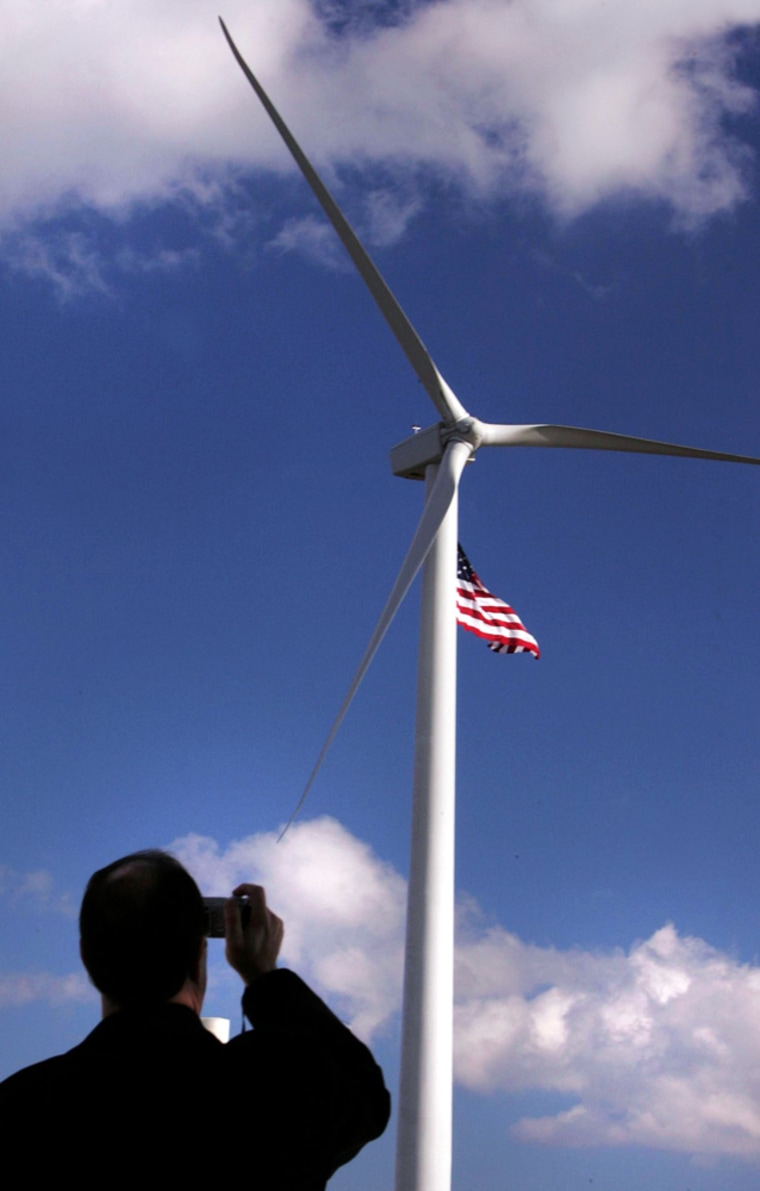Giant windmills — on scenic mountain ridges, prairie grass and even an Indian reservation — are spinning an unusual debate that is dividing leading environmentalists.
Wind power grew rapidly in 2005, becoming more competitive as natural gas prices jumped and crude oil prices reached record highs. Improved technology, a federal tax credit and pressure on utilities to use clean energy sources helped fuel the growth from coast to coast.
But wind energy is posing a dilemma for environmentalists who support its pollution-free electricity but have grown increasingly alarmed at its death toll on birds and bats.
Officials in Atlantic City, N.J., dedicated the nation's first coastal wind farm last month, while Fairfield-based General Electric Co. announced a startup near San Diego of the largest wind power farm on Indian land.
The industry added about 2,500 megawatts of wind power last year, a record 35 percent increase, according to the American Wind Energy Association, an industry trade group. The country's wind capacity is more than 9,200 megawatts in 30 states, enough for 2.4 million average U.S homes.
Wind power still makes up less than 1 percent of the nation's electricity, but experts expect wind to generate at least 5 percent by 2020.
"The wind resource in the United States is comparable to the oil resource in Saudi Arabia," said Tom Gray, deputy executive director of the association. "It's a major strategic national resource we should be making every effort to develop."
The environmental debate has intensified as the first offshore projects are proposed in popular tourist areas, such as Cape Cod, Long Island, N.Y., and the New Jersey shore. Critics, including a member of the influential Kennedy family, worry that some projects could harm national treasures.
"All of a sudden you're transferring an asset used by 5 million people into the hands of private industrial speculators," said Robert F. Kennedy Jr., an environmentalist who has objected to the Cape Cod proposal. "If you're giving away public rights, you ought to make sure the public benefits from this transfer, that the costs do not exceed the benefits."
Kennedy's stance has put him at odds with the environmental organization Greenpeace, which last August sent boats to interrupt a visit by Kennedy. Supporters say the project would meet the region's energy needs in an environmentally friendly way.
Conservationists also have wrestled with the wind farms.
In Kansas, conservation groups have asked state officials to create guidelines for wind energy developments, citing concerns that more wind farms will harm the last remnants of the nation's prairie grass and prairie chicken populations.
"We feel rather protective of that area and feel it is a real national treasure," said Alan Pollom, Kansas state director of The Nature Conservancy. "If we're really going to capture the benefit of green power, it seems ill considered to pursue it in such a manner that you create offsetting detrimental ecological impacts."
In September, a report by the Government Accountability Office, Congress' investigative arm, found that the federal government offers minimal oversight in approving wind power plants. The report urged federal officials to take a more active role in weighing the impact of wind power farms on bird and bat deaths, saying local and state regulators sometimes lack the necessary expertise.
Wind projects have sparked complaints around the country that the windmills cause noise, obstruct scenic views and kill wildlife, including thousands of federally protected birds in California.
In Maryland, state officials have sought to limit 420-foot windmills atop the state's highest mountain ridge because of concerns about the impact to rare species.
A proposal to build offshore wind turbine towers along the New Jersey shore led to a 15-month moratorium on such projects while a special panel studies the issue.
A wind farm planned in a small town in Vermont has sparked criticism that the nearly 400-foot towers would ruin the rural landscape and hurt tourism.
Proponents say bird kills have been minimal at most wind farms, though Gray acknowledged some bird deaths. They say the visual impact is far less severe than other forms of energy such as oil drilling.
Wind power helps lower skyrocketing home heating and electric bills by reducing the demand for natural gas and brings new jobs, rural economic development, and tax revenue to cash-strapped states, proponents say.
In McCamey, Texas, Mayor Sherry Phillips said the population has dwindled over the decades from about 10,000 to 1,800 as oil dried up. But these days the area is remaking itself as the wind farm capital of Texas, collecting millions of dollars in taxes and creating 40 to 50 jobs from 860 wind turbines, she said.
"It's extremely important economically for us," Phillips said. "To me they're a pleasing sight."
The wind power added this year will offset the emission of approximately 7 billion pounds of carbon dioxide, equivalent to keeping nearly 500,000 SUVs off the road, the association said.
"If we could just find a way to make them invisible," Gray said, "we'd have something everybody could get behind."
